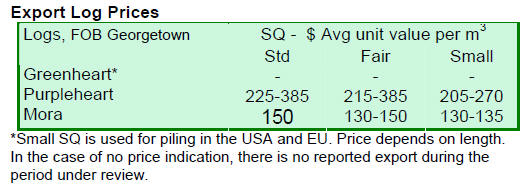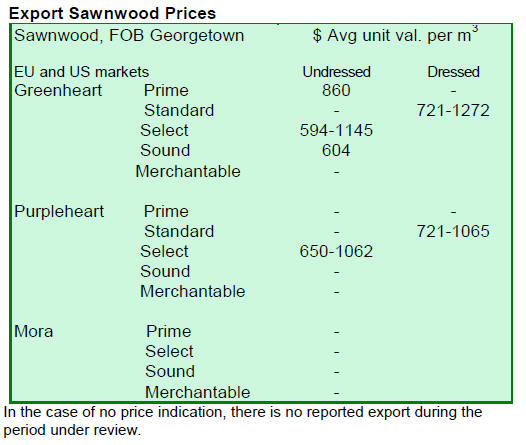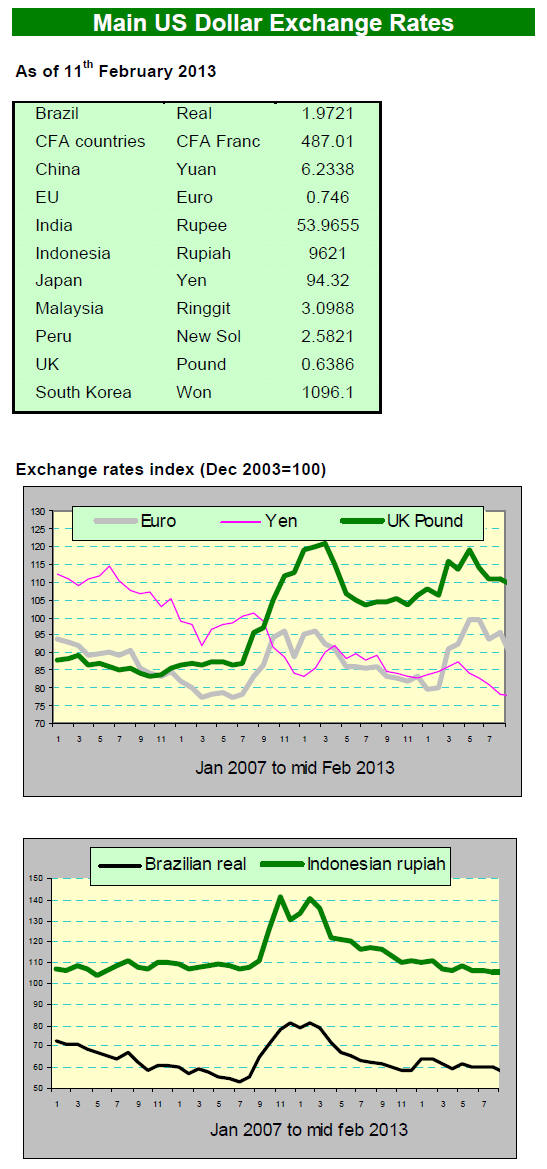2. GHANA
Forestry Commission gears up preparations
for EUTR
A three member Ghanaian delegation is in Europe to participate in a series
of meetings to create awareness of the interim arrangements that Ghana has
put in place to ensure the supply of legal timber to the EU market in
advance of the adoption in Ghana of the FLEGT licensing system.
Ghana will deliver FLEGT licensed wood products to the EU when the Ghana/EU
Voluntary Partnership Agreement is ratified by both parties. The Ghanaian
delegation to the EU plans to meet with Customs Authorities in Belgium.
A series of workshops have been planned in Ghana to create awareness of the
requirements of the EU Timber Regulation. The first workshop will take place
on 21 February 2013 in Kumasi.
The Forestry Commission is working with the Ghanaian Trade Associations in
providing support to firms in meeting the documentary requirements of EU
buyers.
SMEs seek support from the Government
Small-scale timber companies in Ghana have asked the government to try and
find ways to assist in sourcing much needed capital to boost their
businesses and give the whole industry a ¡®make-over¡¯.
According to a statement from the group of small companies, timber
enterprises are finding it very difficult to secure financing for importing
the machinery needed for downstream manufacturing of products such as doors,
knockdown furniture, plywood and joinery etc.
According to an executive from a small-scale company in Sunyani West
District of Brong Ahafo, Mr. Kofi Vinyo, the association representing the
small companies is asking the government to put in place financial
structures and mechanisms for the timber industry to be modernised and thus
contribute more to national development.
Financial institutions in Ghana are reluctant to provide loans to small
companies and many enterprises cannot have access credit. Even if financing
is available small companies find it very difficult to service the loans as
interest rates are high.
Bank of Ghana poised to cut interest rates
Analysts suggest that the Bank of Ghana is likely to cut interest rates when
its rate setting committee meets next month to reconsider its monetary
policy. The head of Databank Research in Accra said there is room for the
monetary policy committee to lower interest rates by as much as 200 basis
points.
The Bank of Ghana has not lowered its
benchmark policy rate since July 2011 when it brought the rate down by 50
basis points to 12.5 percent. In 2012, the Bank boosted the policy rate by
250 basis points to 15 percent as part of a series of actions to stem a
slide in the cedi exchange rate.
¡¡
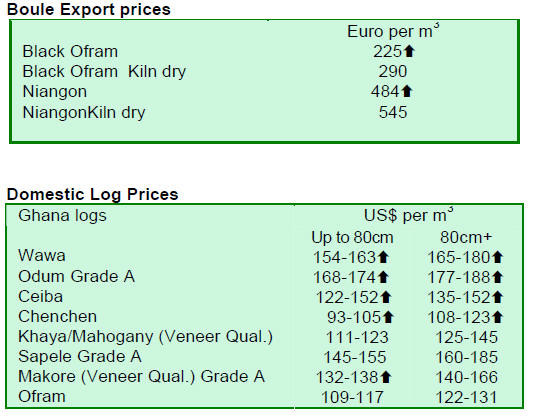
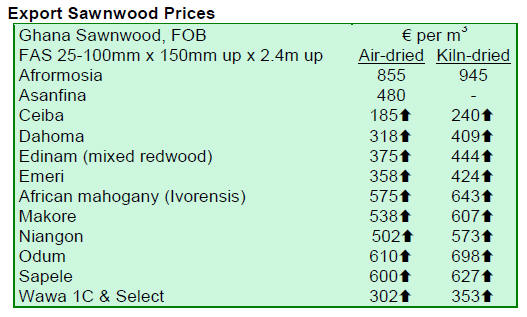
3. MALAYSIA
Industries close to welcome Chinese Year
of the snake
The timber industry in Malaysia traditionally closes for the Chinese New
Year celebrations. This year the Chinese Year of the Snake started on 10th
Feb 2013. Factories in Malaysia are expected to be closed until 18 February.
There is virtually no timber traded during this holiday period.
Furniture exports set to exceed US$2 billion for 2012
The latest national statistics on the timber sector were released for the
period January to November 2012 showing a very healthy export value of RM
18.5 billion (approx. US$ 6.0 billion).
The leading timber sub-sector, in terms of export, was wooden furniture
which reached RM 5.99 billion (approx. US$ 1.93 billion). Plywood exports
were the second highest at RM 4.7 billion (approx. US$ 1.52 billion).
Other major export sub-sectors were sawnwood RM 2.25 billion (approx. US$
726 million), logs RM 1.55 billion (approx. US$ 500 million), MDF RM 1.06
billion (approx. US$ 342 million) and joinery products RM 900 million
(approx. US$ 290 million).
New CEO for Malaysia Timber Certification Council
The Malaysian Timber Certification Council (MTCC) announced the appointment
of Teng Koon Yong as its CEO with effect from 1 Jan 2013. MTCC develops and
operates the Malaysian Timber Certification Scheme (MTCS) as an independent
body. Mr. Yong is a trained forester with considerable experience.
32 percent of Malaysia¡¯s permanent forest certified
The standards under the Malaysian certification system which are used for
auditing forest management practices in the forest management units (FMUs)
and forest plantation management units (FPMUs) are the Malaysian Criteria
and Indicator (MC&I); one for natural forests and another for forest
plantations.
The development and review of the standards had taken into account the
country¡¯s wide geographical spread and involved regional and national level
consultations with multiple stakeholders.
Currently, there are nine FMUs certified under the Malaysian timber
certification system covering an area of 4.65 million hectares and 32% of
the total Permanent Reserved Forests in Malaysia. Certified timber from
these areas is supplied to 171 companies which have obtained Chain of
Custody certification.
No forest plantations have been certified under the Malaysian timber
certification system at present. However, in line with international
practice requireing a certification to standard be reviewed once every five
years, the MC&I (Forest Plantations) is presently undergoing its first
review process.
The MC&I (Forest Plantations) are now being subjected to the first 60-day
public comment period which started from 15 January 2013.
In May 2009, the MTCS became the first tropical timber certification scheme
in the Asian region to be endorsed by the Programme for the Endorsement of
Forest Certification (PEFC), which is currently the leading forest
certification system in the world. Certified companies in Malaysia are
eligible to carry the PEFC logo on their certified timber products.
In July 2012, PEFC endorsed the MC&I (Forest Plantations) as part of the
PEFC endorsement of the MTCS after an independent evaluation report was made
to the PEFC Board. Accordingly, Malaysian companies which own or manage
forest plantations can apply for forest plantation management certification
under the PEFC scheme.
MTCC will be co-hosting the 18th General Assembly of the PEFC in Kuala
Lumpur on 15 November 2013.
Malaysia expects RM 1bil investment from China in 2013
A press release by the Miniser of International Trade and Industry indicates
that Malaysia is expecting about RM1bil. in investment from China this year.
Up to November 2012 the approved investment in the Malaysian manufacturing
sector by Chinese enterprises was RM1.5bil, accounting for 7.8% of the total
foreign investment of RM19.1bil approved for the sector.
The Minister said that Malaysia is hoping for more investments from China
with the development of the joint Malaysia-China Industrial Park in Kuantan
which is expected to be fully operational within two years.
China has been Malaysia's biggest trade partner since 2011, surpassing
Singapore. For the first 11 months of 2012, the total trade between Malaysia
and China was RM165.32bil, 9% higher than the same period in 2011.
The new industrial park is strategically located for investors from ASEAN
and the Asia-Pacific regions and is seen by the Malaysian government as a
possible catalyst for growth on the Peninsular East Coast.
The industries targeted for the site include the manufacture of equipment
for plastics and metal, automotive components, fibre cement boards,
stainless steel products, palm oil processing, carbon fibre, electrical and
electronics, petrochemical, information and communications technology.

¡¡
4. INDONESIA
Exporters urged to diversify
international markets
The Ministry of Forestry recently hosted a press conference for the
Secretary General of the Ministry of Forestry and the head of EU Delegation
for Indonesia, Brunei Darussalam and ASEAN, Ambassador Julian Wilson.
The press conference underscored the cooperation between Indonesia and EU in
respect of the adoption by Indonesia of its new policy for trade in verified
legal wood products.
Both parties agreed to continue to work together to combat trade in
illegally harvested and manufactured wood products through the
implementation of Indonesia¡¯s V-Legal certification scheme for wood product
exports.
Ambassador Wilson encouraged exporters of certified Indonesian wood products
to be confident of the Indonesian scheme and diversify into international
markets.
He further reiterated that the EU member states recognise the credibility of
the Indonesian Timber Legality Assurance Scheme (TLAS) in meeting the market
requirements for the proof of legality of wood products entering the EU.
V-Legal certificates for export to 94 countries
Recent Ministry of Forestry data for exports suggest that, from 1-22 January
a total of 3,427 V-Legal certificates were issued covering more than 1
million cubic metres of logs and wood products. Some of these certificates
were issued for plywood and sawnwood which was exported to some 90
countries.
The Secretary General of the Ministry of Forestry hopes Indonesian wood
products exports to the EU will increase to more than US$1.2 billion this
year.
Group certification for furniture manufacturers
Seven furniture companies in Solo, Central Java, have applied for group SVLK/TLAS
certification under the new scheme set out in the Ministry of Forestry
Regulation Number 38/Menhut-II/2009 amended by Regulation No. P.68/Menhut-II/2011,
as well as the additional amendment in P.45/Menhut-II/2012. This will be the
first experience in group certification for furniture makers.
Plan mooted for ¡®wood terminals¡¯
An official of the Ministry of Industry, Benny Wahjudi, said that the
government will initiate the development of ¡®wood terminals/clearing houses¡¯
for verified legal wood products.
He pointed out that the forestry and timber sectors are strategic industries
and contribute significantly to the Indonesian economy. Over the past 5
years however, wood product exports have been falling, most notably for
pulp, added value products and wooden handicrafts.
The purpose of developing the "wood terminals" for certified legally logged
timber is to strengthen efforts in curbing illegal logging.
It is proposed that wood product manufacturers will be required to purchase
raw materials from the terminals. The Ministry of Forestry official asserted
that some manufacturers may still be tempted to buy illegally harvested
timber because it is cheaper.
With clear regulations and the building of wood terminals to supply logs to
the timber industry the risk of illegal logs entering the supply chain will
be minimised, said the official.
International Furniture and Craft Fair Indonesia
ASMINDO, the Indonesia Furniture and Handicraft Association will organise
Indonesia¡¯s largest annual furniture and handicrafts fair, the International
Furniture and Craft Fair Indonesia (IFFINA) from 11-13 March 2013.
The venue will be the Jakarta International Expo, Jalan H. Benyamin Sueb,
Kemayoran ¨C Jakarta 10610, Indonesia. This Southeast Asian international
fair is expected to attract buyers from over the world .
¡¡
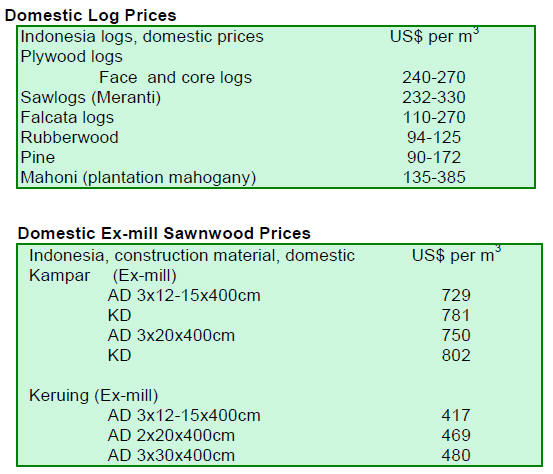
5. MYANMAR
Freshly harvested logs attracting buyers
The Myanma Timber Enterprise (MTE) open tenders for February will be held on
the 22nd and the 25th and a report on the average log prices will appear in
the next TTMR.
Analysts report that the market situation for teak and non-teak hardwoods is
stable and trading is following the usual pattern for the beginning of a
year. Teak logs are being sold easily but, in the case of non-teak
hardwoods, only freshly harvested logs are of interest to buyers.
Logs which were harvested during past cutting seasons are not attracting
buyers and can be sold only at lower prices.
In Myanmar felling and skidding are carried out during the monsoon rains
from May to September and trucking takes place from late November when
forest roads become dry.
If not trucked during the dry season following felling logs must be left
until the next dry season a year later and such logs deteriorate and do not
attract good prices.
Buyers hasten to ship out logs in anticipation of log export ban
The pace of shipments from Myanmar normally reflect the market and stock
positions in the importing countries but since the announcement of a log
export ban in Myanmar beginning April 2014, buyers are seeking faster
shipment of the logs they have paid for.
The following is an estimation of monthly exports over the past months. The
figures are in cubic metres.

Debate on certification continues
The domestic journal ¡®Newsweek¡¯ reported on February 7th that, according to
an official from the Ministry of Environmental Conservation and Forestry (MOECAF),
only verified legally harvested timber will be permitted for export from
2015. The timber industry is yet to respond to this news.
The Myanmar forestry sector has been working for several years towards a
certification system for forest products and representatives from the
European Commission have visited Myanmar to promote the adoption of the EU
FLEGT license system.
The debate on forest and wood product certification in Myanmar has been
arduous and to date no positive results have been achieved. The timber
industries in Myanmar face many difficulties, with poor communication
between the industry in Myanmar and authorities in the importing countries
being a major constraint to achieving progress on certification.
A workshop on ¡®Timber Legality Assurance Systems¡¯ was recently conducted.
Attending the workshop were representatives from the Forest Department,
Myanma Timber Enterprise and the Timber Merchants Association. This workshop
explored the feasibility of a timber legality verification system for the
forestry sector.
Analysts assert that only through the adoption of a legality verification
system can the Myanmar timber industries secure unrestricted access to
markets in the main consuming countries.
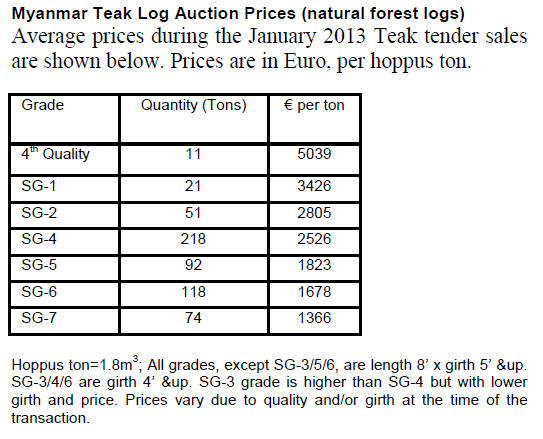
6.
INDIA
Budget expected to focus on stimulating
industrial production
At the end of February the national budget for the coming fiscal year is
expected to be submitted to parliament. Analysts expect the new budget to
contain stimulus measures to address the slowdown in the Indian economy.
This slowdown is primarily the result of weak demand in the main export
markets of the USA and Europe. It is anticipated that the stimulus measures
will focus on boosting industrial production for exports and on checking
inflation.
Over the past year the Indian timber industries have managed to adjust to
the slowing economy and overall market developments.
As mentioned in the previous issue of the TTMR, log imports have been
increasing. The performance of Indian wood product exporters is encouraging
as illustrated in the table below.
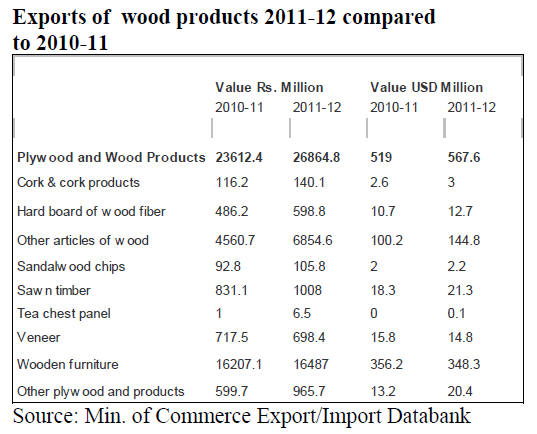
Sales of Teak and other hardwoods from Indian
forests.
The latest average prices for teak and other hardwoods at government teak
depot tenders in Central India are shown below. Prices are in rupees per
cubic foot, ex depot.
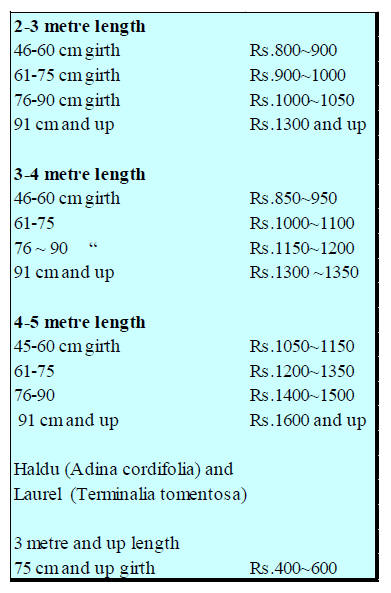
Import volumes of plantation teak logs
India is a major buyer of plantation teak from more than 30 countries.
Imports of natural teak come only from Myanmar.
Details of imports of plantation teak received at Kandla port during the
2011-12 financial year are shown below.
The table provides information on the volume of imports from countries
supplying more than 5000 cubic metres of plantation teak during the year.
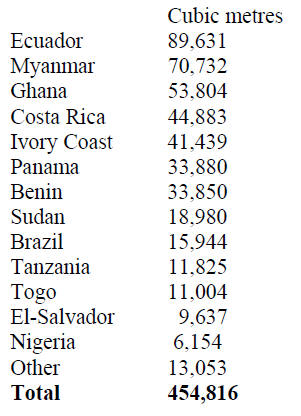
Plantation teak log prices
Current C & F prices per cubic metre for imported plantation teak are shown
below. Analysts report that supplies and deliveries of plantation teak
remain stable and that prices levels have not changed significantly.
Current prices, C & F Indian ports, for plantation Teak are shown below.
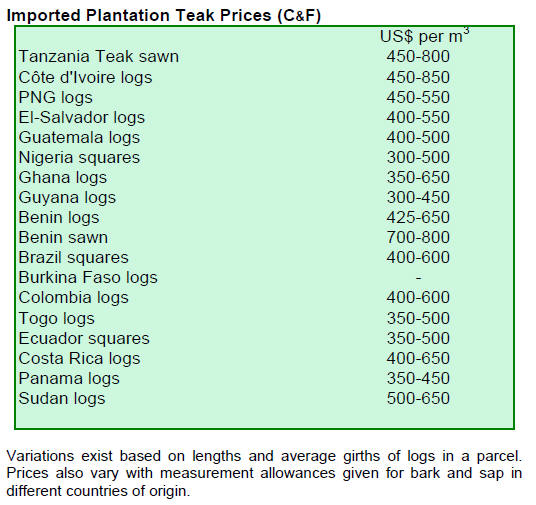
Domestic Ex-mill prices for imported timbers
Domestic prices (per cubic foot ex-sawmill) for air dried sawn timber remain
unchanged and are indicated below.
The price range reflects differences in the length and cross section.
Analysts say the trend to replace teak with other durable tropical hardwoods
continues, driven mainly by the high price of teak.
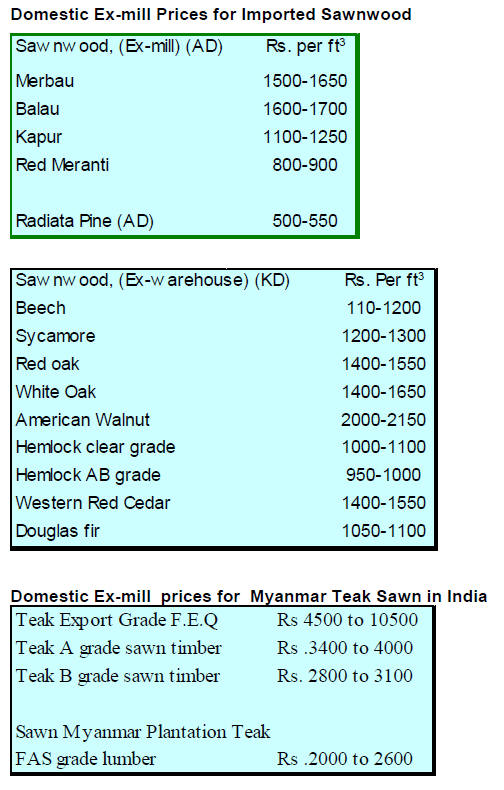
Indian plywood manufacturers investing overseas
The sourcing by Indian plywood manufacturers of core and even face veneers
from Vietnam, Thailand, Malaysia and Myanmar is increasing. There is growing
interest from Indian companies in constructing plywood mills the countries
mentioned above.
7.
BRAZIL
Stimulating private investment in
plantations
The Strategic Affairs Secretariat (SAE) of the Brazilian government is
developing ideas on mechanisms to stimulate more private financing in the
forest sector.
The SAE is investigating a variety of models appropriate for the long term
investment that is necessary for plantation development.
The SAE says that it is necessary to identify or develop a credit mechanism
offering a grace period for repayments for borrowers. At the same time the
SAE recognizes that there is a need to provide guarantees to investors since
plantation development requires substantial investment for periods that can
range from 7 to 35 years before income is generated.
The SAE Secretariat for Sustainable Development has held a series of
meetings with financial analysts to assess options for financial instruments
related to private financing for forest plantations.
According to an SAE advisor, at present there are a variety of financial
models being applied in the agricultural sector but these often only address
the short-term financing needs for agricultural crops. The key difference
between the agricultural and forest plantation sectors is the time until
harvesting generates income.
According to the SAE a research programme will be undertaken on possible
private investment financing models for the development of forest
plantations in Brazil. The aim of the SAE is that a new financing model
should be included in a National Policy for Planted Forests which is also
being formulated by the SAE.
Alagoas State to ensure growth of furniture cluster
The Alagoas State Planning and Economic Development Secretariat (SEPLANDE)
recently met with representatives of Arapiraca¡¯s local government, the
Brazilian Service Support for Micro and Small Enterprises (SEBRAE) of
Alagoas and the steering committee for the development of the furniture
industry in the Agreste region to discuss ways to expand the furniture
industry cluster in Arapiraca.
Through such a meeting the partnership between the state and the
manufacturing sector is strengthened.
The State has invested resources to support the promotion of a furniture
manufacturing cluster in the region and emphasised the need for effective
participation of entrepreneurs in the management of activities in support of
the cluster. Currently, the Agreste Furniture Industry Association (Amagre)
is taking the lead in this undertaking.
The furniture cluster in this region has grown in recent years with the
support of local and state governments and now extends to an area of 96,000
sq.m with 45 plots for micro-enterprises.
Many micro-industries cannot afford to invest in their own storage buildings
and to address this a building will be provided through a partnership
between the Arapiraca local government and the State Government.
The building of the community storage capacity will, it is hoped, encourage
more small companies to the cluster and will result in greater employment
opportunities in the municipality of Arapiraca, State of Alagoas, located in
the Northeast Brazil.
Rio Grande do Sul furniture manufacturers up-beat on export prospects in
2013
The state of Rio Grande do Sul was the only state reporting a year on year
growth in furniture exports in 2012. However, the level of growth in 2012
compared to 2011 was only 1.1% for a total export for 2012 or US$ 205.7
million.
The Bento Gonçalves furniture cluster, the largest in the state, chalked up
a 4.4% increase in exports in 2012 to US$ 63 million. Overall Brazil¡¯s
furniture exports in 2012 fell by 5.2% to US$ 723.4 million.
Thise data is presented in a report published by the Rio Grande do Sul State
Furniture Industry Association (MOVERGS), in collaboration with the
Innovation Management Center (CGI Moveleiro) and the Foreign Trade
Secretariat of the Ministry of Foreign Trade, Industry and Development (MDIC).
The report identifies Uruguay, the United Kingdom, Chile, Peru, and the
United States as major importing countries for furniture from Rio Grande do
Sul in 2012. However, Argentina was the largest importer of Brazilian
furniture in 2012.
While the 2012 data is not very encouraging, MOVERGS says that the latest
statistics indicate signs of recovery in furniture exports. Manufacturers
have been trying to achieve product differentiation, investing in exclusive
designs and applying the latest technology to improve the competitiveness of
Brazilian furniture.
MOVERGS is forecasting a 10% growth in regional furniture exports but
analysts point out that, after taking into account likely inflation levels
and increases in the price of inputs and raw materials, the most optimistic
forecast for the national furniture sector is a net growth of 3%.
High hopes for ¡®Brazil M¨®veis¡¯ international furniture fair
The international furniture fair ¡°Brazil M¨®veis¡±, planned for August 6-9,
2013 in São Paulo, is one of the largest fairs for the furniture sector.
This year the fair is expecting around 200 of the national furniture makers
to exhibit.
The organisers report that around 45% of the exhibition area is already
booked and some 30,000 national and international visitors are expected.
Exhibitors have expressed expectations that the 2013 fair will be the
springboard for their success with international buyers. The pace of growth
in the Brazilian construction sector should give a boost to the furniture
sector this year.
According to the Rio Grande do Sul State Furniture Industry Association (MOVERGS)
during 2012 consumers have invested in remodeling of homes but now there is
greater interest in new home building a trend that will increase demand for
new furniture.
According to the Institute of Industrial Studies and Marketing (IEMI), the
domestic furniture sector could grow 5.5% this year, up on the 2.8% growth
last year. MOVERGS has suggested that the exemption of the sector from
payroll taxes and the tax on Industrialized Products (IPI) and the efforts
by industry to better meet consumer demand will improve competitiveness.

¡¡
8. PERU
Peru commended for improved
management of mahogany trade
The Deputy Minister for Foreign Trade, Carlos Posada, recently met with
business representatives to discuss the implications for the forestry sector
arising from the Forest Trade Promotion Agreement (CPA) concluded with the
United States.
The Deputy Minister congratulated the work being done by Peruvian companies
to ensure the sustainable management of forests.
Exports of big leaf mahogany and spanish cedar from Peru to the US will
continue with export licenses for these species to be issued by the Ministry
of Agriculture, through the General Directorate of Forestry and Wildlife.
Peru has undertaken a series of regulatory reforms in respect of the
issuance of export permits for mahogany and spanish cedar to ensure
traceability of the legal origin of the products.
In other news related to the trade in mahogany, the Standing Committee of
CITES publicly congratulated the Peruvian government for the progress made
in the management of the mahogany trade. Further, the CITES Committee agreed
to delete the requirement for specific reporting on the management of
mahogany, and encourage Peru to include additional information in their
national reports.
Public and private sector cooperation on forestry agenda
The public sector, represented by the Ministry of Foreign Trade and timber
and forestry private sector representatives agreed to continue working
together to safeguard the resources of the Amazon thereby bring benefits to
both the local population and the national economy.
The private sector was represented by Adex, the National Society of
Industries (SNI), the National Forest (CNF) and the Peruvian Confederation
of Woodworkers (CPM), among others.
The ADEX Wood and Timber Industry Committee Chairman, Erik Fischer,
highlighted the potentials of the Peruvian Amazon and the need for industry
to work with the ministries of Foreign Trade and Tourism (Mincetur) and
Agriculture (Minag) as well as the Agency for the Supervision of Forest
Resources and Wildlife (OSINFOR) and regional governments.
The ADEX representative said that the forestry sector needs a better legal
framework that encourages investment. He said there is a need to improve the
quality of forest regulation such that companies are encouraged to stay on
in the timber business.
He added some public institutions do not appear well equipped to meet
challenges of bringing value to the Amazon forests and people.
Highway checkpoints visited
The regional president of Madre de Dios Jorge Soto Aldaz¨¢bal, accompanied by
facility staff, recently visited the Regional Forestry and Wildlife
checkpoints located along the Inter-Oceanic Highway between Puerto Maldonado
and Iñapari. The purpose of the visit was to verify the situation under
which these check points operate.
The delegation not only verified the working conditions at each of the
checkpoints but also met with employees to listen to their concerns. The
regional president urged workers to become the main allies of his
administration in the fight against corruption.

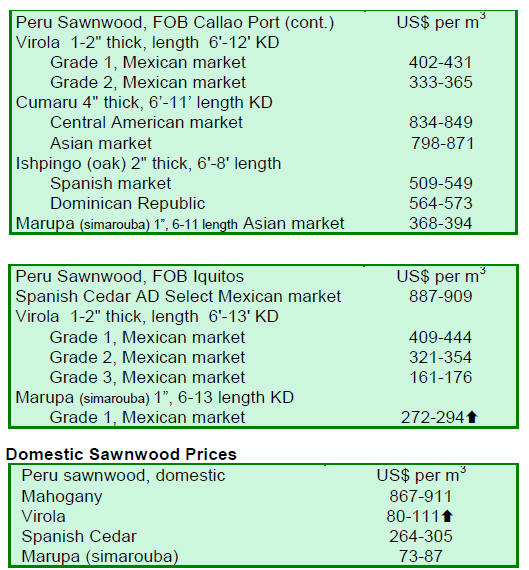
9.
GUYANA
Purpleheart logs attract favourable
prices
Guyana did not export any Greenheart logs in the period under review.
However, some shipments of Purpleheart logs were made and the Guyana
Forestry Commission reported that prices were at favourable levels. The
maximum price for Standard Sawmill Quality Purpleheart log rose as high as
US$385 per cubic metre.
Purpleheart Fair Sawmill Quality logs were traded at a top price of US$300
per cubic metre while Small Sawmill Quality Purpleheart logs fetched US$ 270
per cubic metre.
Mora log export prices remained unchanged from price levels reported earlier
for all Sawmill log qualities.
Prices for Greenheart sawnwood (Undressed) rise
During the period under review average export prices for Greenheart Select
sawnwood (Undressed) moved up from US$721 to US$1,145 per cubic metre.
Analysts report that a significant sale of Grenheart Select sawnwood was
made to buyers in the French West Indies at premium prices. On the other
hand, Greenheart Sound sawnwood (Undressed) suffered a decline in export
price from US$721 to US$604 per cubic metre.
Sawn Purpleheart (Select, Undressed) export prices were favourable with the
top price achieved was as high as US$1,062 per cubic metre.
There were no exports of Mora sawnwood (Undressed) during the period but
Mora sleepers were exported to the Caribbean market.
Prices for dressed sawnwood ended mixed
Over the past two weeks, Dressed Greenheart sawnwood export prices were firm
at as much as US$1,272 per cubic metre up from the US$1,039 recorded
previously reported.
However Dressed Purpleheart sawnwood export prices dipped from the high of
US$1,081 per cubic metre to just US$1,065 per cubic metre in the period
reviewed.
As always, Dressed Washiba (Ipe) enjoyed a satisfactory export price of
US$2,500 per cubic metre.
Plywood and added value products fetch good prices
Plywood export prices were significantly higher in the latest round of
shipments compared to the prices reported in the previous report earning as
much as US$ 1,988 per cubic metre. The Caribbean and Central and South
American destinations are the main markets.
Splitwood (Shingles) attracted good export price of US$ 795 per cubic metre
while other value added products continue to contribute to Guyana¡¯s total
timber export earnings.
Single block of 1.6 million hectares of forests verified legal
Barama Co. Ltd (BCL), a logging and wood products manufacturing company in
Guyana, is one of the largest operational foreign companies in the country.
At full production the company employs around 1000 workers.
BCL operates in a 1.6 million hectare concession. The company has worked to
secure internationally recognised forest certification through an SFM model
defined by the Edinburgh Centre for Tropical Forest which was subsequently
refined into a Code of Practice for timber harvesting.
BCL has worked with the Tropical Forest Trust (TFT) to develop a Verified
Legal Origin (VLO) system for their operations.
The Rainforest Alliance was contracted to develop a certification scheme for
BCL and when this was completed an audit of the standards was undertaken for
the company¡¯s up-stream and down-stream operations.
BCL was successfully audited in July 2012 resulting in the issuance of the
certificate in November 2012. As a result, BCL now claims to have the
largest single block of VLO tropical forest in the world an achievement
which will create opportunities for the company to increase its market share
internationally and to promote verified legal timber from Guyana.
Comprehensive planning puts Guyana in good stead for negotiations on VPA
Guyana and the European Union have begun formal dialogue on a Voluntary
partnership Agreement (VPA). The first formal negotiations were held in
December 2012 at which key timelines were agreed that will guide the process
forward.
In announcing its decision to begin negotiations on the VPA the Guyana
government indicated that it was aware of the potential benefits of the EU
FLEGT licensing scheme in stimulating market demand and enabling Guyana¡¯s
exporters to retain market share in the EU.
The commencement of formal dialogue with the EU was preceded by a series of
stakeholder meetings and consultations that helped the government take the
decision to enter into formal negotiations.
The Government of Guyana, FAO, EU and local stakeholder groups were
instrumental in supporting a process of sharing information, conducting
initial analyses and assessing potential impacts and benefits of a VPA for
Guyana.
As a result of the engagement with stakeholders there is now a broader
understanding of the major issues that need to be addressed during the
negotiation process.
In a joint statement issued by the Government of Guyana and the EU in June
2012, the parties agreed to commence formal negotiations by the end of 2012,
with the objective of concluding negotiations on a VPA by September 2015,
according to an agreed roadmap which will be developed jointly.
The parties emphasised that the agreement should have the objectives of
adding value to forest governance, forest industry development and
sustainability of the forestry sector. Additionally, the statement
underlined the assurance that the extractive industry within Guyana will not
be limited by any interventions made under the VPA.
So far, a number of steps have been taken, including the establishment of a
VPA Secretariat in Guyana which is located within the Guyana Forestry
Commission, the formation of a multi-stakeholder steering body for the VPA
negotiation and implementation efforts and the development of a Guyana
Roadmap for EU FLEGT negotiations.
In September 2012, through a mult- stakeholder process, Guyana collaborated
with international and local experts to develop a Guyana EU FLEGT Roadmap to
guide the negotiations process in Guyana.
This effort involved the participation of various stakeholder
representatives from the private sector, civil society, NGOs, Government and
other groups, in shaping the Roadmap which contains both activities that
Guyana will itself undertake, as well as those aspects that will be jointly
undertaken by Guyana and EU.
The process of negotiations on the VPA will include a strong element of
stakeholder participation. As part of the management structure developed to
oversee the VPA negotiations in Guyana, several meetings of a steering body
called the National Technical Working Group (NTWG) have already been held.
Additionally, specific stakeholder constituency meetings have been concluded
and there are plans to continue with these sessions throughout the
negotiation process. To date, four meetings of the NTWG have been held. Ten
meetings of separate key stakeholder constituency groups, mainly targeting
indigenous Groups, NGOs and the private sector have been held.
In early February, the NTWG and the EU held its first joint technical
meeting at which both parties started work on discussing the various aspects
of the VPA with the aim to commencing drafting of key sections. The
discussions will continue at the next scheduled meeting planned for July
2013.
Amongst the priority technical activities discussed in preparation for the
July meeting is the legality assurance system for Guyana which involves
aspects of the definition of forest legality and wood tracking systems.
The NTWG has expressed confidence that Guyana¡¯s existing systems for forest
management and legality, including its log tracking and chain of custody
management systems that have been in place since 2001, are robust enough to
serve as a solid foundation for the VPA.
This assessment took into account the programmes being implemented in Guyana
such as Independent Forest Monitoring, VLO certification at company level
and the development of a framework for legality assurance.
As the formal effective date of the EUTR approaches (March 2013), Guyana has
outlined plans to expand its communication efforts to local and
international stakeholders to share information on the efforts made so far
in the EU FLEGT VPA process, as well as details of existing operational
systems in Guyana on which the FLEGT VPA can be built. The government is
confident that it can fulfil the requirements of the EUTR through its
current system of verified forest legality.
